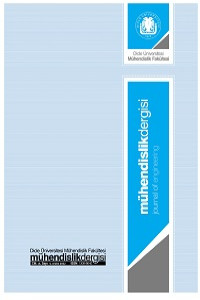Investigation of the Conveyor Capacity in Different Angle Belt Conveyors with Discrete Element Method (DEM)
Öz
Capacity in belt conveyors, which implies the amount of material conveyed per second, changes depending on the conveyor angle. The capacity of the inclined conveyors is calculated via using a general inclination coefficient (k), which is taken from the table. The inclination coefficient here is used for various types of conveyors, regardless of the design of the conveyor and properties of the bulk material, hence features an approximation in the estimation of the capacity. In this study it is aimed to acquire the capacity of the conveyor for each angle numerically with Discrete Element Method (DEM), without the need of an inclination coefficient. The capacities of the belt conveyors with different inclination angles were found theoretically and numerically in the study. The design-specific inclination coefficient of the conveyor was acquired via using the numerical conveyor capacities, which was later compared with the general inclination coefficient (theoretical). The numerical conveyor capacity and inclined coefficient were to be found lower than their theoretical counterparts.
Anahtar Kelimeler
Belt Conveyors Discrete Element Method DEM Conveyor Capacity
Proje Numarası
FBA-2022-3847
Kaynakça
- [1] Cundall, P. A., Strack, O. D. L.: A discrete numerical model for granular assemblies. Geotechnique (1979). https://doi.org/10.1680/geot.1979.29.1.47
- [2] Ilic, D., Wheeler, C. A.: Transverse bulk solid behaviour during discharge from troughed belt conveyors, Advanced Powder Technology (2017). https://doi.org/10.1016/j.apt.2017.06.024.
- [3] Rozbroj, J., Nečas, J., Gelnar, D., Hlosta, J., Zegzulka, J.: Validation of movement over a belt conveyor drum. Advances in Science and Technology Research Journal, 11, 118-124. (2017)
- [4] Rossow, J., Coetzee, C.J.: Discrete element modelling of a chevron patterned conveyor belt and a transfer chute, Powder Technology (2021), https://doi.org/10.1016/j.powtec.2021.06.012.
- [5] Hastie, D.B., Wypych, P.W.: Experimental validation of particle flow through conveyor transfer hoods via continuum and discrete element methods, Mechanics of Materials (2010), https://doi.org/10.1016/j.mechmat.2009.11.007.
- [6] Pezo, M., Pezo, L., Jovanović, A. P., Terzić, A., Andrić, L., Lončar, B., Kojić, P.: Discrete element model of particle transport and premixing action in modified screw conveyors, Powder Technology (2018), https://doi.org/10.1016/j.powtec.2018.06.009.
- [7] Owen P.J., Cleary P.W.: Prediction of screw conveyor performance using the Discrete Element Method (DEM), Powder Technology, Volume 193, Issue 3, Pages 274-288, ISSN 0032-5910, (2019) https://doi.org/10.1016/j.powtec.2009.03.012.
- [8] Govender, N., Cleary, P. W., Wilke, D.N., Khinast, J.: The influence of faceted particle shapes on material dynamics in screw conveying, Chemical Engineering Science (2021), https://doi.org/10.1016/j.ces.2021.116654.
- [9] Conveyor Equipment Manufacturers Association (CEMA): Belt Conveyors For Bulk Materials, 5th edition, (2002)
- [10] Shen, J., Wheeler C., O'Shea, J., Ilic, D.: Investigation of the dynamic deflection of conveyor belts via experimental and modelling methods, Measurement (2018), https://doi.org/10.1016/j.measurement.2018.05.091.
Öz
Bantlı konveyörlerde birim zamana bağlı olarak taşınan malzeme miktarını ifade eden konveyör kapasitesi; konveyörün eğimine bağlı olarak değişmektedir. Eğimli olarak çalışan konveyörlerin kapasitesi, genel bir eğim faktörü (k) tablosu üzerinden seçilen değerler kullanılarak bulunmaktadır. Buradaki eğim faktörü konveyör tasarımı ve taşınan malzeme özelliklerine bağlı olmadan, tüm konveyörler için aynı olarak kullanılmaktadır. Böylelikle konveyör kapasitesi yaklaşık olarak hesaplanmaktadır. Bu çalışmada hedeflenen, konveyör kapasitesinin genel olarak kullanılan eğim faktörüne ihtiyaç duyulmadan, Ayrık Elemanlar Metodu (Discrete Element Method) (DEM) kullanılarak her açı için numerik olarak bulunmasıdır. Çalışmada farklı eğimlerdeki konveyörler için kapasite değerleri teorik ve numerik olarak bulunmuştur. Numerik olarak bulunan kapasite değerleri yardımıyla konveyörün tasarımına ait eğim faktörü elde edilmiştir. Elde edilen eğim faktörü değeri, endüstride yaygın olarak kullanılan genel eğim (teorik) faktörü değerleriyle kıyaslanmıştır. Numerik olarak elde edilen konveyör kapasitelerinin ve eğim faktörünün, teorik yöntemdeki değerlerden daha düşük olduğu bulunmuştur.
Anahtar Kelimeler
Bantlı Konveyörler Ayrık Elemanlar Metodu DEM Konveyör Kapasitesi
Destekleyen Kurum
Yıldız Teknik Üniversitesi Bilimsel Araştırma Projeleri Koordinasyon Birimi
Proje Numarası
FBA-2022-3847
Teşekkür
Bu çalışmada; Altair Engineering Inc. & ST firmasının Altair EDEM yazılım kullanılmış olup, yazarlar destekleri için firmaya ve çalışanlarına teşekkürlerini sunmaktadırlar.
Kaynakça
- [1] Cundall, P. A., Strack, O. D. L.: A discrete numerical model for granular assemblies. Geotechnique (1979). https://doi.org/10.1680/geot.1979.29.1.47
- [2] Ilic, D., Wheeler, C. A.: Transverse bulk solid behaviour during discharge from troughed belt conveyors, Advanced Powder Technology (2017). https://doi.org/10.1016/j.apt.2017.06.024.
- [3] Rozbroj, J., Nečas, J., Gelnar, D., Hlosta, J., Zegzulka, J.: Validation of movement over a belt conveyor drum. Advances in Science and Technology Research Journal, 11, 118-124. (2017)
- [4] Rossow, J., Coetzee, C.J.: Discrete element modelling of a chevron patterned conveyor belt and a transfer chute, Powder Technology (2021), https://doi.org/10.1016/j.powtec.2021.06.012.
- [5] Hastie, D.B., Wypych, P.W.: Experimental validation of particle flow through conveyor transfer hoods via continuum and discrete element methods, Mechanics of Materials (2010), https://doi.org/10.1016/j.mechmat.2009.11.007.
- [6] Pezo, M., Pezo, L., Jovanović, A. P., Terzić, A., Andrić, L., Lončar, B., Kojić, P.: Discrete element model of particle transport and premixing action in modified screw conveyors, Powder Technology (2018), https://doi.org/10.1016/j.powtec.2018.06.009.
- [7] Owen P.J., Cleary P.W.: Prediction of screw conveyor performance using the Discrete Element Method (DEM), Powder Technology, Volume 193, Issue 3, Pages 274-288, ISSN 0032-5910, (2019) https://doi.org/10.1016/j.powtec.2009.03.012.
- [8] Govender, N., Cleary, P. W., Wilke, D.N., Khinast, J.: The influence of faceted particle shapes on material dynamics in screw conveying, Chemical Engineering Science (2021), https://doi.org/10.1016/j.ces.2021.116654.
- [9] Conveyor Equipment Manufacturers Association (CEMA): Belt Conveyors For Bulk Materials, 5th edition, (2002)
- [10] Shen, J., Wheeler C., O'Shea, J., Ilic, D.: Investigation of the dynamic deflection of conveyor belts via experimental and modelling methods, Measurement (2018), https://doi.org/10.1016/j.measurement.2018.05.091.
Ayrıntılar
| Birincil Dil | Türkçe |
|---|---|
| Bölüm | Makaleler |
| Yazarlar | |
| Proje Numarası | FBA-2022-3847 |
| Erken Görünüm Tarihi | 31 Aralık 2022 |
| Yayımlanma Tarihi | 3 Ocak 2023 |
| Gönderilme Tarihi | 5 Ekim 2022 |
| Yayımlandığı Sayı | Yıl 2022 Cilt: 13 Sayı: 4 |

